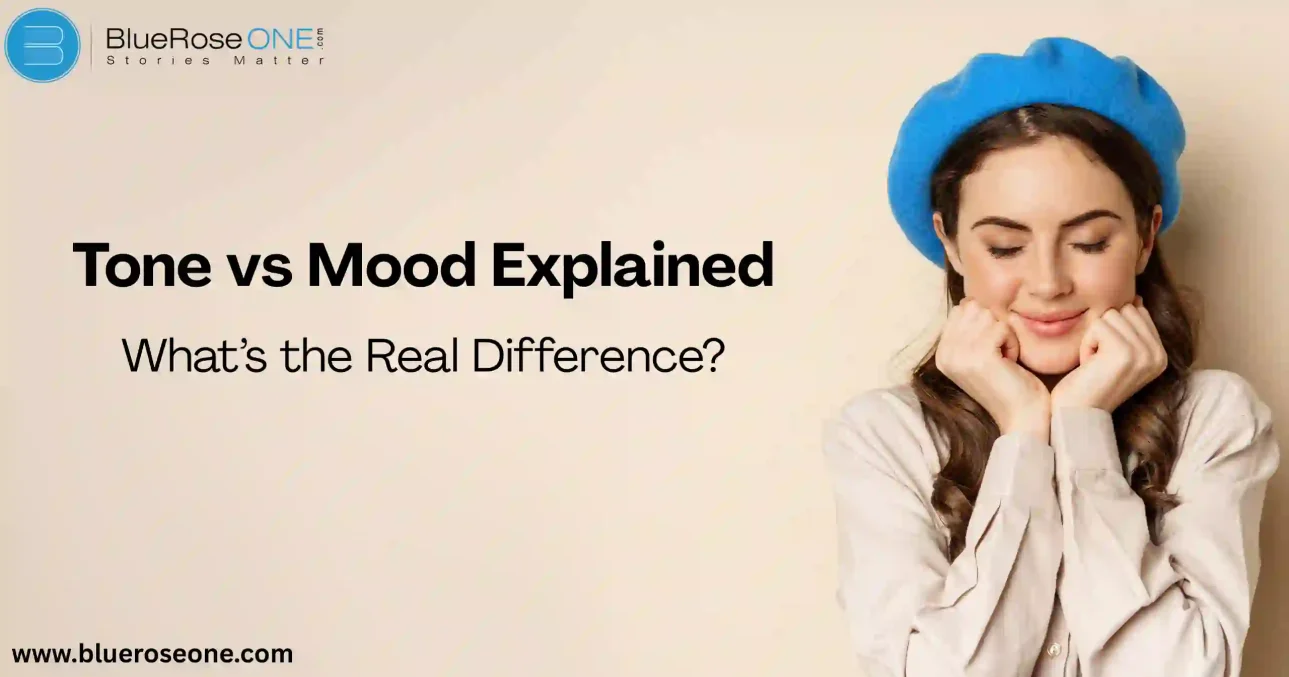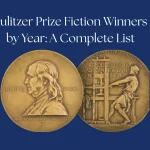Why Tone and Mood Confuse So Many Readers
We’ve all been there reading a story and wondering, “Wait, is this the author’s tone or the mood I’m feeling?” They’re not the same, and yet they’re so often confused.
Today, we’ll break it all down with simple definitions, relatable examples, and tips to help you spot the difference every time.
Tone and mood are like identical twins in the world of literature. At first glance, they seem the same but they’re totally different once you get to know them.
Many readers (and even writers) use the terms interchangeably, which leads to a lot of confusion.
Importance of Knowing the Difference
When you understand how tone and mood work, you can fully appreciate a writer’s craft, write more effectively, and even analyze texts like a pro. It’s not just academic, it’s essential for storytelling.
You may also like: 150 Useful Tone Words to Describe Tone | Explanation with Examples
What is Tone in Literature?
Definition of Tone
In literature, tone refers to the author’s attitude or feelings toward the subject matter, characters, or audience, as conveyed through their choice of words and writing style. It reflects how something is said, not just what is said.
For example, an author might write about love in a hopeful, sarcastic, bitter, or melancholy tone. The tone influences how readers emotionally respond to a story or poem.
Think of it as the “voice” behind the words.
Key Points About Tone:
- It is conveyed through word choice, sentence structure, imagery, and details.
- Tone can be formal or informal, serious or humorous, sympathetic or critical, etc.
- Understanding tone helps readers grasp the deeper meaning or emotional layers of a text.
Common Tone Examples
- Sarcastic
- Optimistic
- Angry
- Respectful
- Playful
- Serious
Examples from Famous Books
- “The Catcher in the Rye” by J.D. Salinger – Tone: Cynical, rebellious
- “Pride and Prejudice” by Jane Austen – Tone: Witty, ironic
- “To Kill a Mockingbird” by Harper Lee – Tone: Compassionate, reflective
How Authors Convey Tone
Writers show tone through:
- Word choice (diction)
- Sentence structure
- Figurative language
- Dialogue
- Punctuation
You may also like: Tone Examples in Literature: 15 Must-Know Types With Examples
What is Mood in Literature?
Mood in literature refers to the emotional atmosphere or overall feeling that a reader experiences while reading a story. It is the emotional effect created by the setting, tone, word choice, and events within a literary work.
Key Points:
- Mood is what the reader feels – such as sadness, joy, fear, suspense, nostalgia, etc.
- It is crafted by the author using descriptive language, imagery, and setting.
- Mood helps enhance the reader’s emotional connection to the story and its characters.
Common Mood Examples
- Tense
- Romantic
- Mysterious
- Hopeful
- Melancholy
- Uplifting
Mood in Classic and Modern Literature
- “The Road” by Cormac McCarthy – Mood: Hopeless, bleak
- “Harry Potter and the Sorcerer’s Stone” by J.K. Rowling – Mood: Magical, adventurous
- “1984” by George Orwell – Mood: Oppressive, paranoid
How Mood Impacts the Reader
The mood shapes how you connect emotionally with the story. It affects:
- Your level of engagement
- Your interpretation of events
- Your emotional investment in characters
You may also read: Additionally Synonyms and Antonyms for Students & Writers

The Core Differences Between Tone and Mood
Who Feels It: Author vs. Reader
- Tone: The author’s feeling.
- Mood: The reader’s feeling.
Created By vs. Felt From
- Tone is created by how something is written.
- Mood is created by what is written, setting, imagery, and more.
Example: A character gives a heartfelt speech at a funeral.
- Tone: Respectful and solemn
- Mood: Sad and emotional
Tone vs Mood at a Glance
| Aspect | Tone | Mood |
|---|---|---|
| Creator | Author | Reader |
| Expression | Author’s attitude | Reader’s emotional response |
| Conveyed By | Word choice, dialogue | Setting, atmosphere |
| Examples | Sarcastic, respectful | Tense, joyful |

How to Identify Tone
Pay Attention to Word Choice
Word choice is important in determining tone because it reveals an author’s attitude toward the subject.
Formal language may convey seriousness or respect, but slang or colloquialisms can convey a relaxed or amusing tone.
Descriptive adjectives, verbs, and even punctuation all contribute to tone words like “delighted” or “furious” elicit vastly distinct emotions. Readers can determine the tone of a text by thoroughly examining certain word choices.
Look at the Narrator’s Attitude
One of the most efficient methods for determining tone is to examine the narrator’s attitude toward the subject, people, or events.
This attitude is frequently expressed through word choice, sentence construction, and descriptive language.
Is the storyteller snarky, serious, affectionate, or detached? For example, a sarcastic tone may involve exaggeration and irony, whereas a sincere tone use honest, direct language.Understanding how the narrator feels allows readers to grasp the emotional undercurrent that drives the narrative.
You may also like: 100 Adjectives Start with Z (With Meanings & Examples)
Dialogue and Description Cues
Pay close attention to the speech and descriptive cues to determine the tone. Characters’ speech patterns, such as word choice, sentence length, and emotional intensity, might indicate the author’s viewpoint.
Sarcastic remarks, formal language, and emotional outbursts all convey varied tones. Similarly, descriptive passages frequently have tonal weight; for example, gloomy imagery may indicate a somber tone.
When these cues are analyzed together, readers can determine whether the tone is humorous, critical, respectful, or something else.
How to Identify Mood
Setting the Atmosphere
One of the most effective ways to identify mood in literature is to examine the setting and atmosphere. The physical location, historical period, weather, and surroundings all influence the emotional tone of a scene.
For example, a dark, stormy night in an abandoned house can create a sense of suspense or fear.
Authors use descriptive language and sensory details to create this atmosphere, guiding readers to experience an emotional response that is consistent with the story’s intent.
You may also like: Realistic Fiction: Definition, Key Elements and Examples
Reader’s Emotional Reaction
Examining your own emotional response while reading is one of the most effective ways to determine the mood of a text.
Mood is the overall feeling or atmosphere that a writer creates, and it frequently elicits specific emotions in readers, such as sadness, suspense, joy, or fear. Setting, word choice, imagery, and tempo all influence how people react.
If a section makes you feel apprehensive or hopeful, it is most certainly a reflection of the piece’s intended mood.
Music and Imagery Cues
Observing music and visual signals is a useful method for determining mood in literature.
Authors frequently employ vivid descriptions such as eerie silence, thundering waves, or soft moonlight to elicit particular emotional reactions, even though they are not always genuine.
The mood of the text is also influenced by allusions to rhythm or music, such as lively festival melodies or eerie lullabies. Whether the intended tone is one of joy, tension, melancholy, or hope, these sensory nuances help readers experience it.
Why Writers Must Master Both
Strengthening Emotional Impact
By mastering tone and mood, authors may connect with readers on a deeper emotional level. Mood influences the reader’s emotions, whereas tone conveys the author’s perspective.
A scene’s emotional resonance increases when these components are purposefully positioned in opposition to or in alignment with one another.
For instance, a warm tone in a nostalgic mood might arouse strong emotion, whereas a caustic tone in a tragic mood can emphasize irony. Stories become more emotionally impactful, engrossing, and memorable as a result of this synergy.
You may also like: Throne of Glass Series: The Right Order to Read
Deepening Character Development
Mastering tone and mood is vital for character development. Tone exposes a character’s internal voice how they think, feel, or react while mood influences how readers emotionally engage with that character’s journey.
Tone, when properly aligned, can hint at internal conflicts or growth, whereas mood immerses the reader in the atmosphere surrounding those changes.
This dual skill enables authors to create more detailed, emotionally compelling characters that feel genuine, engaging, and fully present in the story’s environment.
Controlling the Reader’s Journey
Mastering tone and mood is critical for authors because it allows them to control how readers experience a tale.
Tone helps to establish the author’s attitude, shaping how information is perceived whether serious, sarcastic, or optimistic.
Meanwhile, mood immerses readers in the emotional atmosphere, influencing how they feel scene after scene.
They serve as a compass and emotional map, ensuring that readers react, interpret, and connect with the narrative exactly as the author intended.
You may also like: Shatter Me Series in Order: Don’t Read Them Out of Turn!
Teaching Tone and Mood in Classrooms
Fun Activities and Examples
- Compare the tone in different versions of the same text.
- Create mood boards using pictures for scenes.
- Rewrite a paragraph to change the tone or mood.
Tips for Students to Remember the Difference
- Tone = Author
- Mood = Me (the Reader)
A good mnemonic trick that actually works!
Conclusion
Tone and mood may look similar, but they play very different roles. One is the author’s voice, the other is your emotional reaction. Learn to separate them, and you’ll read deeper, write better, and enjoy literature on a whole new level.















